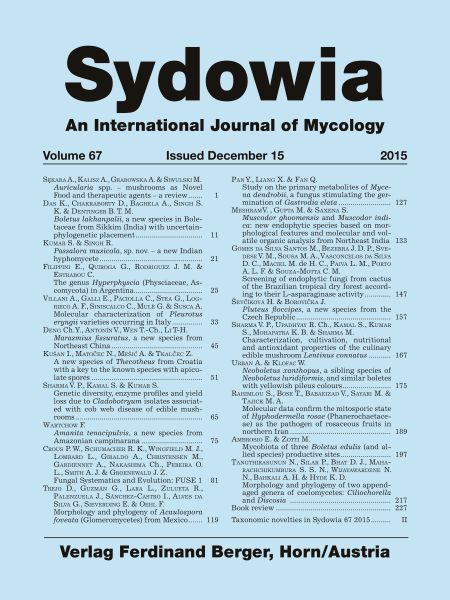
Sydowia Vol. 67/E-Book/S 189-196
Molecular data confirm the mitosporic state of Hyphodermella rosae
Download-Artikel
Artikel Nr 2431
Preis 9,30 €
Lieferstatus 

Buchbeschreibung
In: Sydowia 67, (2015): 189-196 DOI 10.12905/0380.sydowia67-2015-0189Molecular data confirm the mitosporic state of Hyphodermella rosae (Phanerochaetaceae) as the pathogen of rosaceous fruits in northern Iran
Saleh Rahimlou, Tanay Bose, Valiollah Babaeizad, Mohammad Sayari & Mohammad Ali Tajick
Hyphodermella is a genus of corticioid white rot fungi from the Phanerochaetaceae. Molecular data (partial SSU, LSU and complete ITS nrDNA) confirm the mitosporic state of Hyphodermella rosae as the causal agent of dry fruit rot of plum (Prunus domestica) and peach (Prunus persica) from Mazandaran, Iran. The asexual state of H. rosae is characterized by the presence of unicellular, spherical mitospores, which are terminal or intercalary in position. Both basidia and mitospores were observed in the matured cultures of H. rosae, although we did not observe any basidiospores. The phylogeny of Phanerochaetaceae confirms Hyphodermella as a monophyletic lineage within the family and sister group to Phanerochaete with considerable bootstrap support. Both the isolates of mitosporic H. rosae nest within a clade, which includes its sexual counterpart. Hence, we conclude that the lifecycle of H. rosae includes at least two reproductive states, i.e. sexual and asexual. Mitosporic H. rosae is capable of infecting plants and produce similar disease symptoms as its sexual state.
Keywords: Basidiomycota, dry fruit rot, mitospore, multi-gene phylogeny.
Rahimlou S., Bose T., Babaeizad V., Sayari M. & Tajick M. (2015) Molecular data confirm the mitosporic state of Hyphodermella rosae (Phanerochaetaceae) as the pathogen of rosaceous fruits in northern Iran. – Sydowia 67: 189–196.





